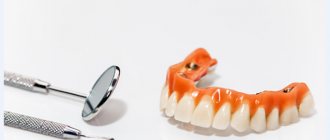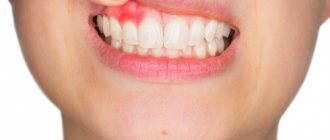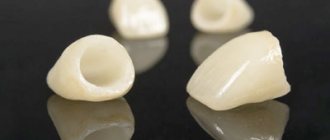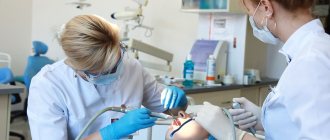There are many different myths and assumptions associated with the concept of an eye tooth. This is due to the fact that most young parents do not know where these units are located and why they received such a name. In practice, the situation is much simpler - in dentistry, the fangs of the lower and upper jaw are usually called eye teeth.
The eye teeth (hereinafter referred to as the eye teeth) are localized near the nerve of the same name, which is why they received a name similar to it. Symptoms of the eruption of these units in a baby are extremely painful (due to irritation of the optic nerve). Thus, a child whose maxillary canine is being cut may complain of unbearable pain, profuse lacrimation, general weakness, increased body temperature and encounter other unpleasant symptoms.
Important! Due to this localization, adult incisors are removed exclusively under local anesthesia.
Which teeth exactly have such a strange name?
So, the term “eye teeth” is not a medical term. The correct name for these teeth is upper canines. Where did such a strange name come from? The fact is that in the immediate vicinity of the upper fangs there are threads of the facial nerve. When these threads are irritated, very severe pain occurs in the upper part of the face. This pain even extends to the eyes.
When babies' upper canines begin to erupt, pain occurs that makes children cry. Unfortunately, this process takes quite a long time. Removal of eye teeth in adults is also always accompanied by severe pain. In this case, dentists use very strong anesthesia.
From somewhere there are ridiculous rumors that a person can even go blind from the removal of eye teeth. Such cases are unknown to medicine.
Features of fangs
The first canine is formed in the embryo's body at the time of intrauterine development. Like other masticatory organs, these units originate from the dental epithelial lamina. Their main difference is that they are deeply embedded in the bone tissue. Permanent rudiments also begin to form in babies in the womb. This happens according to the principle of time units. What are the cardinal distinctive features of fangs? They differ from other chewing organs primarily in structure.
- The root shape is significantly elongated.
- The cutting edge connects to the large crown at a pointed angle.
- The units in the upper jaw are all larger than those in the lower row, since the contact surface is increased.
- The canines have flat crowns. Therefore, the lips and tongue do not come into contact with the cutting edge.
If a child's fangs grow crookedly, this problem cannot be ignored. The baby needs to be taken to the dentist. The specialist will identify the cause and prevent serious complications. If the bite is incorrect, children's braces will be required. Wearing them is mandatory so that the body does not suffer from gastrointestinal diseases due to inadequate chewing.
External features of eye teeth
Eye teeth are visually very different from both the front teeth and molars. The eye tooth has only one root. It is relatively long and slightly flattened. The crowns of the eye teeth have two cutting edges located at an acute angle to each other. They also have a slightly flattened shape.
The upper eye teeth are noticeably larger and longer than the lower ones. Their cutting surface is much wider than that of the lower canines.
Nature entrusted these teeth to hold food in the mouth and tear food into pieces.
Formation of eye teeth in children
Children's milk teeth erupt in a strictly defined sequence. Each tooth is waiting its turn to appear in the baby’s mouth.
Children's eye teeth begin to erupt only after all the incisors and first molars have appeared. The upper canines begin to erupt first. This usually happens at the age of one and a half years. The lower canines begin to appear when the baby is 20 months old.
This delay is explained by the fact that the roots of the eye teeth penetrate into the depths of the bone tissue much deeper than the other teeth.
During eye teething, children experience more than just pain. Most of them experience a slight increase in body temperature. Running noses and even swelling in the oral cavity often occur. Young mothers often perceive all this as a child’s illness. Meanwhile, this is a completely natural, albeit unpleasant, process. It cannot be any other way, because at this time the gums next to the baby’s teething teeth become inflamed.
Only in the rarest cases can babies experience coughing, diarrhea and even vomiting at this time. However, these are symptoms of another random disease that has nothing to do with the appearance of eye teeth.
Reasons why a tooth may hurt
The appearance of toothache often comes as a surprise, because it can occur even if the teeth appear to be completely healthy. In any case, if you feel pain in your teeth, you should immediately visit a dentist.
First, the specialist will find out the cause of the pain (hypersensitivity, caries or something else). There are several types of causes of tooth pain:
- bacterial (gum disease, pulpitis, caries);
- mechanical damage to the enamel;
- general diseases.
Let's look at the most common causes of toothache in more detail:
Caries. Toothache due to enamel destruction
The most common cause of toothache is diseases caused by the proliferation of bacteria that can destroy tooth enamel from the outside and inside.
A lot of people have caries, and not all of them know about it. The disease manifests itself in the form of darkened spots on the surface of the teeth. It is interesting that at first the spots are white and can stand out against the background of the darker surface of healthy enamel - this is the stage when bacteria are still destroying the tooth shell with the products of their vital activity.
As caries progresses, bacteria penetrate deeper into the center of the tooth, the focus of the disease becomes wider and can cover neighboring teeth. By breaking through the mineral layer and reaching the soft dentin, the carious process accelerates.
At the culmination stage of caries, if the disease is not treated properly, bacteria penetrate the pulp, covering the vascular and nervous tissue, as a result of which the tissue becomes inflamed and begins to ache. This is how pulpitis develops. Treatment of this disease consists of cleaning the soft insides of the tooth, disinfecting the tooth cavity and placing a filling, sometimes (in particularly advanced situations) requiring removal of the affected nerve.
Pulpitis. Dental nerve pain
Pulpitis is an inflammation of the neurovascular bundle located in the tooth. The pulp (vessels and nerves of the tooth) swells and affects the walls of the chamber, which causes pressure on the nerve endings. This is where severe pain arises, intensifying every day. A common cause of pulpitis is caries, which progresses too much due to lack of timely treatment. Microbes, toxins and other harmful substances make their way from there to the nerve and interact harmfully with its tissues.
Powerful painkillers will help you quickly get rid of acute pain. But for complete and high-quality treatment, you need to contact qualified specialists. How do dentists deal with infection that affects the nerve of a tooth?
- Anesthesia is used for the affected area;
- The pulp chamber is opened;
- The nerve is removed;
- Clean the canals located at the root;
- The canals are washed and then filled;
- Place a filling on the crown
The pain with pulpitis and with caries is different. With caries, it is not strong, it increases with the consumption of cold and hot drinks and dishes, and inhalation of cold air. The pain associated with pulpitis is acute and unbearable, appears at unexpected moments, for example, in the middle of the night, and can radiate to the temples, cheeks and nose (if a tooth in the upper jaw is affected), ear and neck (if a tooth is affected in the lower jaw). With pulpitis, the pain persists for a long time, without subside or weakening, but with caries it subsides when the irritant disappears (example: sweets fall on a tooth affected by caries - the tooth hurts, remove the sweets - the pain subsides).
Another possible cause of pain is diseases resulting from untreated or neglected caries or pulpitis - cysts, granulomas, periostitis (festering of the gums in addition to symptoms of pulpitis or caries), periodontitis (swelling of the gums, mucous membranes, sometimes parts of the face, often with any absence of pain).
Eruption of wisdom teeth and the appearance of pericoronitis
During the growth of the last tooth in a row, people experience severe pain that affects the cheeks, jaw and even throat. Toothache during tooth growth is aching and pulling, and can be accompanied by pain in the head and neck, as well as pericoronitis - inflammation of the gum tissue caused by a lack of available space on the jaw. A tooth can erupt under the gum hood correctly or incorrectly. In the first case, the gum hood is excised to facilitate its development and save the patient from suffering.
Incorrect eruption of wisdom teeth is caused by a lack of space in this area of the gum. Its further growth will be accompanied by severe pain, inflammation, complications and may even lead to death. To avoid this, doctors advise immediately removing the harmful tooth and not allowing it to develop further.
In this case, you must immediately contact a surgeon. Self-treatment will not bring results, but will only hasten the development of sepsis, phlegmon, and in the worst case, death.
Gingivitis. Gum inflammation
The gums can be affected by diseases such as periodontal disease or periodontitis. With such inflammation, bleeding and pain in the gums are observed, and chewing food becomes especially painful. Most patients perceive these sensations as toothache. Such diseases can lead to exposure of tooth roots, which explains increased sensitivity. If the infection passes quickly or is not noticed in time, then pathogenic bacteria can penetrate even into the pulp, which can lead to the loss of a tooth, or even several.
Periodontitis
Periodontitis is characterized by inflammation of the tissues around the tooth root. The dead pulp remains inside the canal and its purulent contents flow to the gum. This provokes severe acute pain that prevents you from even touching the tooth. The patient has difficulty chewing food and drinking too cold/hot drinks.
Periodontitis is an exacerbation of gingivitis, periodontitis, and pulpitis. Another cause of the disease can be poor oral hygiene, bad habits, and careless surgical procedures.
It is impossible to get rid of pain during periodontitis on your own; urgent and mandatory medical intervention is needed. Doctors will open the canal for a certain amount of time to allow the pus to drain out. Thanks to soda/soy rinses, microbes will begin to die, and therefore inflammation will stop.
ARVI, sinusitis, sinusitis
Bacterial and viral diseases such as sinusitis or sinusitis affect the mucous membranes of the sinuses, which is dangerous for the teeth due to their close proximity to the jaw.
Such inflammation can lead to pain in the upper row of teeth. A similar situation can happen to the lower jaw if a person has a sore throat or pharyngitis, for example, since with such inflammation the lymph nodes suffer.
Injuries, tooth root fracture, cracks and chips
Chips of fillings, injuries to the tooth roots and cracks in the enamel can be the consequences of mechanical damage caused by bruises or chewing too hard food. In this case, the patient may experience pain not only from the injury, but also due to inflammation, which appears as a result of infection entering the pulp through cracks. The pain in this case can be sharp, dull, strong or weak, so an x-ray or orthopantomogram (OPTG) is necessary to identify the exact cause of the disease.
Whitening procedures and pastes with abrasive particles
Teeth whitening can lead to increased sensitivity (hyperesthesia). This happens during the procedure because the removal of the bacterial layer is followed by a violation of the mineral composition of the enamel. If this happens, then usually all teeth suffer, but the front teeth receive the greatest damage, since they are in the visible zone, and they are whitened especially carefully.
A hard toothbrush and strong pressure while brushing
Everyone knows that brushing your teeth should be done twice a day for 2 minutes , but few people know that it is also important to choose a toothbrush with the right level of hardness and not put too much pressure on your teeth during procedures. Fulfilling these conditions is very important for maintaining healthy teeth and oral cavity. If you ignore these factors, you can easily damage the enamel, which will result in aching pain in your teeth or increased sensitivity to high and low temperatures.
Hypothermia and inflammation of the facial nerves
Inflammation of the trigeminal nerve is a well-known and unpleasant ailment. Undoubtedly, spending time outside is very beneficial for the health and immunity of people of all ages. But long walks when the temperature on the thermometer has exceeded -20 and the absence of a hat in windy weather can lead to such a painful and aching pathology as inflammation of the dental nerves.
General diseases of the body
In the fast pace of modern life, not every person can remain completely healthy. A large information load leads to chronic fatigue, stress and neurological disorders. The listed ailments affect the functioning of the brain: it begins to transmit distorted nerve signals that can reach the teeth and cause aching pain. In this case, you should first go not to the dentist, but to a psychotherapist or neurologist.
Pain in the lower jaw or lower molars may be due to cervical chondrosis. This pathology appears in people who lead a sedentary lifestyle, mainly at the computer. The head remains in one position for a long time, which causes the spine to bend and lead to compression of blood vessels/nerves, and all this has an extremely negative effect on the sensations in the teeth.
Stomach pathologies have a negative impact on the condition of teeth. For example, with heartburn, stomach acid enters the oral cavity and destroys the enamel. Because of this, dentin is exposed, which leads to increased sensitivity of the tooth.
Lack or improper intake of vitamins, dietary disorders
It is known that acids can cause hyperesthesia, accompanied by pain in the teeth. For children, the elderly and people with sensitive enamel, it is best to avoid foods with vinegar and citric acid. You should take vitamin C only when necessary and with non-acidic foods (for example, rosehip decoction). By the way, rose hip decoction contains more vitamin C than lemon.
Berries, fruits, vegetables, herbs, cottage cheese, eggs and nuts are essential components of a healthy person’s diet. Due to their absence, the mineralization of the enamel worsens, which means the oral mucosa suffers. Without beneficial and useful substances in the body, the enamel is destroyed: it becomes thin, susceptible to cold and hot, and reacts sharply to solid foods.
Imaginary acute toothache really exists! Many believed that it was a fantasy of overly emotional and impressionable people. However, there is a scientific explanation for this. After a tooth is removed, the nerve endings of the gums in its place begin to actively recover, which leads to phantom sensations. This condition can last for several weeks and goes away on its own.
How to ease the baby's suffering?
It is impossible to ensure completely painless eruption of eye teeth. However, you can help your baby in several ways.
A light massage of the gums slightly dulls the pain. In any case, this stops the kids from crying. To do this, you need to gently stroke the gum just above the eye tooth for a couple of minutes. This massage can be done two to three times a day.
Now pharmacies sell special teethers. Before using, keep them in the refrigerator for a while. These simple products are filled with distilled water. If the baby bites through the shell, then nothing bad will happen.
You can dull the pain with the help of anesthetic gels Dentinox, Kalgel or Kamistad. They begin to act a few minutes after application to the gums.
If the baby’s nose is stuffy during the teething of the eye teeth, then in this case it is worth using drops of Otrivin, Nazivin or Quix. They tend to constrict blood vessels. It also happens that the body temperature of babies rises to 38 degrees or higher. In this case, you have to resort to antipyretic children's drugs paracetamol or ibuprofen. They are available in the form of syrups or candles.
If the baby is having too much trouble with the teething of the eye teeth, then in such a situation it is better to call a pediatrician at home.
Eye teeth in teenagers
The permanent lower eye teeth are formed at the age of 9-10 years. The upper fangs appear after 1-2 years.
In a healthy child, the formation of permanent eye teeth is painless. If this process is accompanied by pain, then this indicates a serious problem. This usually happens if diseases of the oral cavity occur, such as gumboil, pulpitis, periodontitis or other inflammatory processes. In such a situation, you should not try to get rid of the problem yourself. The most you can do is take a painkiller and immediately go to the dentist.
Diagnosis of toothache. Features of complications in the absence of treatment
The correct diagnosis can only be established after examining the oral cavity. The dentist must analyze complaints, obtain information about concomitant ailments, previous injuries and find out the nature of the pain. Then prescribe adequate treatment
A visual examination by a doctor may include the following manipulations:
- applying light tapping movements to the tooth to determine the location of the pathology;
- determining the reaction to exposure to heat;
- examination of the condition of the enamel using a special lamp or laser;
- study of the condition of dentures, if any;
- X-ray diagnostics to identify foci of inflammation, root fractures and other hidden problems;
- 3D computed tomogram, which allows you to obtain a three-dimensional model of an organ, view the internal structure of the bones, identifying neoplasms and cysts.
CT scan.
Network of dentists “Smile”, Shchelkovo Whatever the toothache is - severe, low-intensity, nagging, sharp, appeared today or has been lasting for several days - make an appointment with a dentist. Even if the pain has subsided and does not manifest itself at all, you cannot cancel the visit. Some insidious diseases (such as pulpitis) can behave changeably: after a sudden exacerbation, some relief may occur. However, you should not wait for the next attack or hope that the disease has gone away on its own and the pathological process has stopped.
Note! Before visiting the dentist, do not take medications that relieve pain - analgesics (tablets, injections). This will blur the symptoms, and it will be difficult for the doctor to make a diagnosis, not to mention the correct treatment regimen, due to the dulling of symptoms by painkillers.









